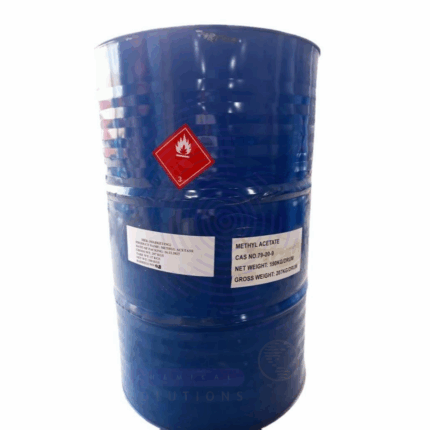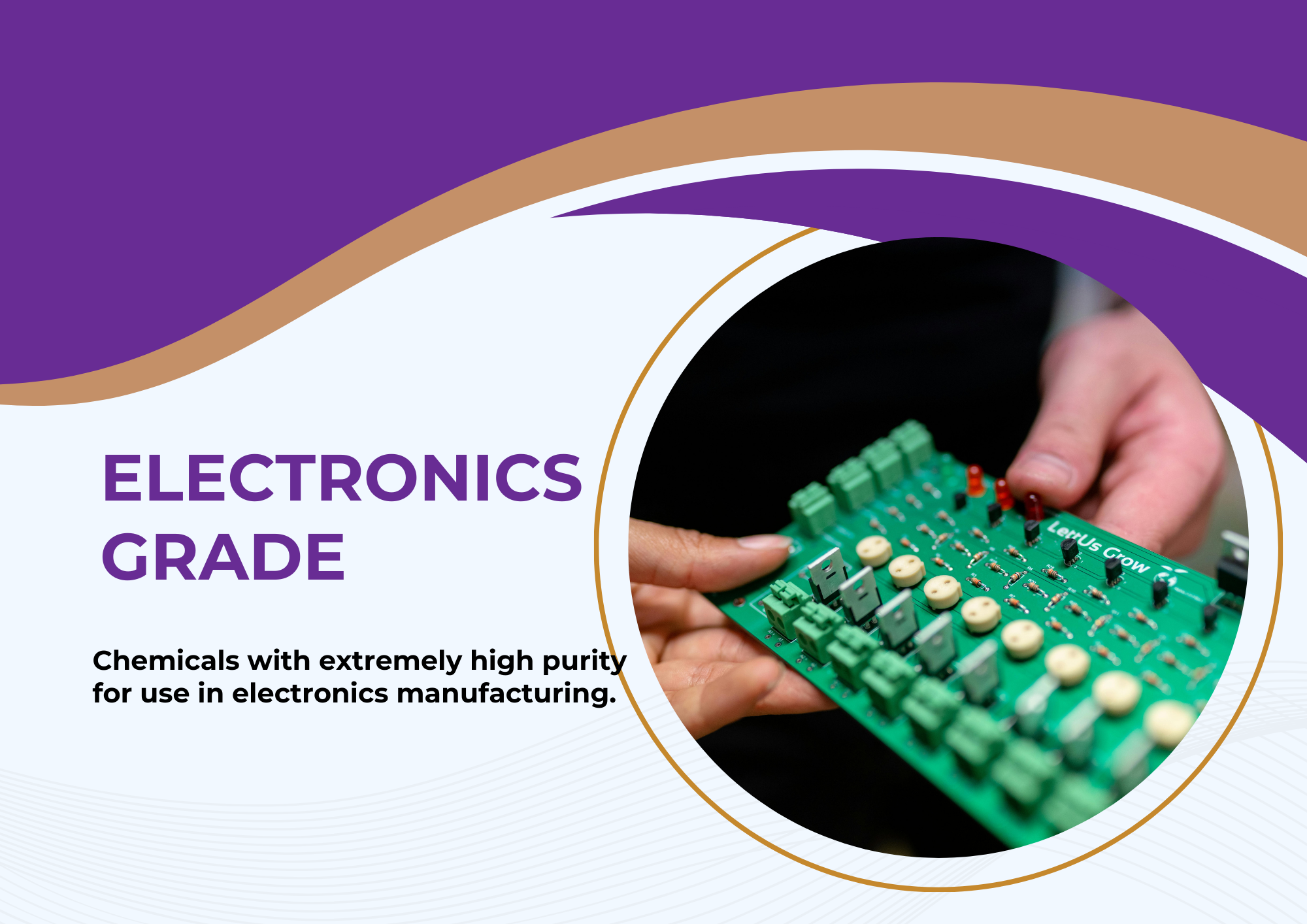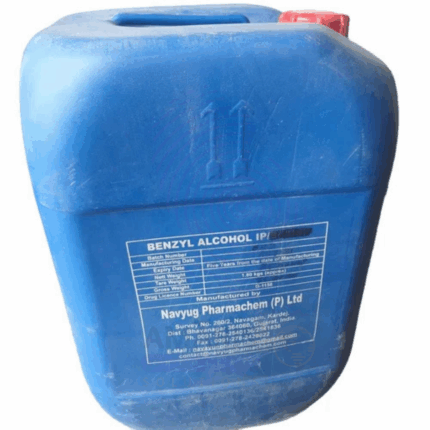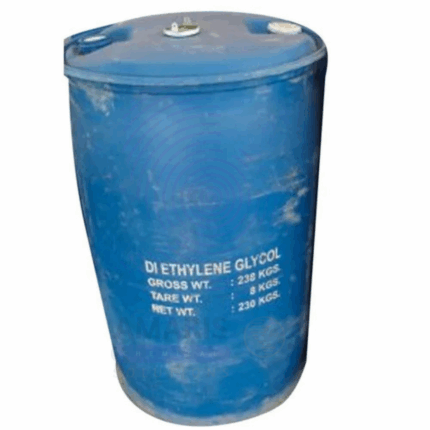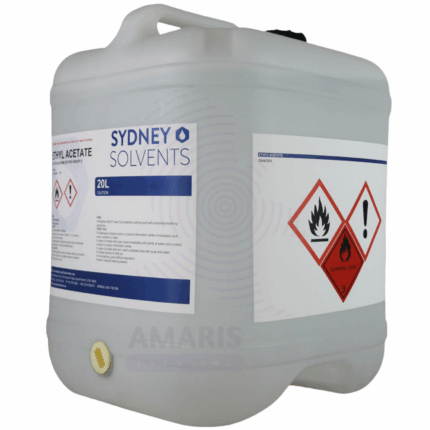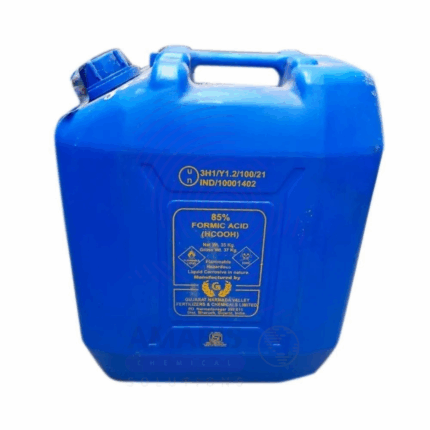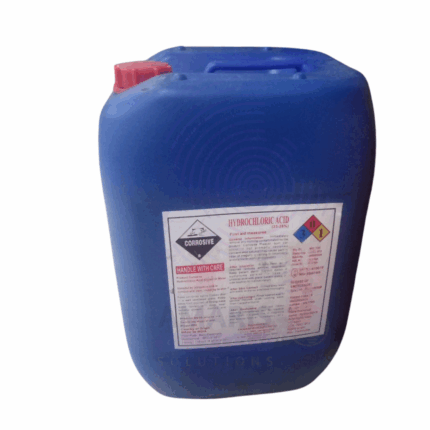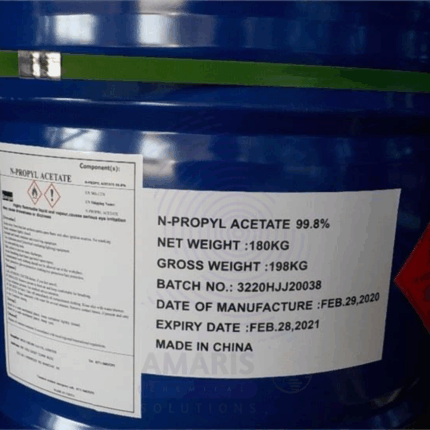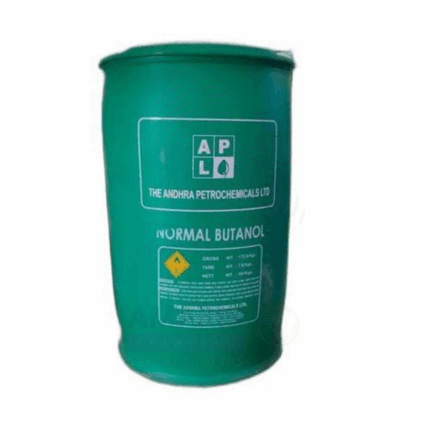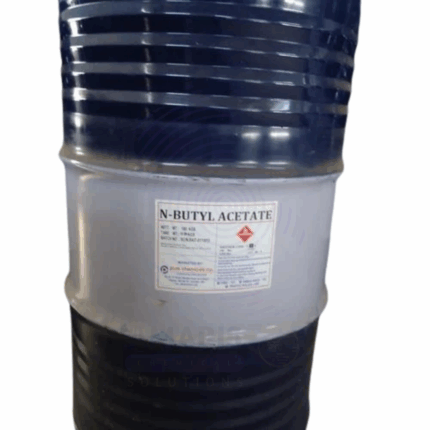Ethoxy Propanol
Ethoxy Propanol, also known as Propylene Glycol Monoethyl Ether (PnP), is a clear, colorless, low-viscosity solvent with a mild ether-like odor. It belongs to the family of glycol ethers and is miscible with water and most organic solvents. Ethoxy Propanol is widely valued for its excellent solvency, moderate evaporation rate, and compatibility with both polar and non-polar systems. It is extensively used in coatings, inks, cleaners, and chemical synthesis applications due to its balance of performance and safety.
Ethoxy Propanol Uses
Primary Uses
Paints, Coatings & Inks
- Acts as a coalescing agent in water-based paints and coatings to ensure film formation and durability.
- Used as a solvent for resins, dyes, and pigments in architectural, automotive, and industrial coatings.
- Improves flow, leveling, and gloss in latex paints and varnishes.
- Helps reduce surface tension in inks and improves drying time and print quality.
Cleaners & Degreasers
- Employed as an active solvent in household, institutional, and industrial cleaners due to excellent grease-cutting ability.
- Used in glass and hard-surface cleaners for streak-free drying and effective removal of oily residues.
- Compatible with surfactants and alkaline builders in formulation of degreasers and heavy-duty detergents.
Adhesives & Sealants
- Functions as a solvent or plasticizer in waterborne adhesives and sealants, aiding in uniform film formation and drying.
- Enhances wetting and open time in formulation, improving application performance.
- Compatible with polyurethane, acrylic, and phenolic adhesive systems.
Textiles & Leather Processing
- Used as a solvent carrier in textile printing pastes and dyeing formulations.
- Helps control evaporation and improve uniformity in leather finishing processes.
Electronics & Semiconductor Industry
- Used in precision cleaning of electronic components due to low residue and controlled evaporation.
- Employed in solvent blends for photoresist and printed circuit board cleaning.
Chemical Intermediate
- Serves as a building block in the synthesis of surfactants, solvents, and agrochemical formulations.
- Used in manufacturing esters, plasticizers, and other specialty chemicals.
Secondary Uses
Automotive Applications
- Added to fuel system cleaners and carburetor cleaners for its solubilizing and cleaning properties.
- Used in vehicle polish and detailing formulations for improved spreading and film integrity.
Printing Industry
- Included in printing inks for improved pigment dispersion, drying control, and substrate adhesion.
- Helps maintain print sharpness and uniformity in high-speed printing processes.
Cosmetics & Personal Care
- Occasionally used as a solvent or carrier in formulations like hair sprays, perfumes, and lotions (non-irritating at low concentrations).
- Contributes to volatility and spreadability of fragrances or actives.
Agrochemical Formulations
- Used as a solvent or carrier in pesticide and herbicide formulations for better active ingredient dispersion and penetration.
Key Attributes
Basic Identification Attributes
- Chemical Name (IUPAC): 1-Ethoxy-2-propanol
- Common/Trade Name: Ethoxy Propanol, Propylene Glycol Monoethyl Ether (PnP)
- CAS Number: 1569-02-4
- HS Code: 2909.49.00
- Molecular Formula: C₅H₁₂O₂
- Synonyms:
- PnP
- Ethyl Propylene Glycol Ether
- 2-Propanol, 1-ethoxy-
- EPh (in some industrial contexts)
Physical & Chemical Properties
- Appearance: Clear, colorless liquid
- Odor: Mild, ether-like
- Boiling Point: ~135°C
- Melting Point: −90°C
- Flash Point: ~48–52°C (closed cup)
- Density (20°C): ~0.90 g/cm³
- Solubility: Completely miscible with water, alcohols, and many organic solvents
- Evaporation Rate: Moderate (slower than acetone, faster than glycols)
- Viscosity: Low (~2.0 cP at 20°C)
- Vapor Pressure: ~3.5 mmHg at 20°C
- Refractive Index: 1.405–1.410
Safety & Hazard Attributes
- Hazard Class (GHS):
- Flammable Liquid, Category 3
- Eye Irritation, Category 2A
- Toxicity: Low to moderate; inhalation and prolonged skin contact may cause irritation
- Exposure Limits:
- ACGIH TLV (TWA): Not specifically established
- Use in well-ventilated areas to limit vapor buildup
Storage & Handling Attributes
- Storage Conditions: Store in cool, dry, well-ventilated area; away from heat, sparks, and open flames
- Container Type: HDPE drums, metal drums, or IBCs
- Shelf Life: Typically 12–24 months in unopened containers
- Handling Precautions: Ground and bond containers when transferring; use flame-proof equipment where applicable
- Incompatible Materials: Strong oxidizing agents, acids, alkalis
Regulatory & Compliance Attributes
- Listed on major international chemical inventories (TSCA, EINECS, REACH)
- Acceptable in food-contact coatings under specific regulatory limits (check regional guidelines)
- Not classified as a hazardous air pollutant (HAP) under U.S. Clean Air Act
- May contribute to VOC content in regulated formulations (regulated under CARB, SCAQMD, etc.)
Environmental & Health Impact
- Ecotoxicity: Moderate — avoid direct discharge to surface water
- Persistence: Biodegradable under aerobic conditions
- Bioaccumulation: Low potential
Carcinogenicity/Mutagenicity: Not classified as carcinogenic or mutagenic
Safety Handling Precautions
PPE Required:
- Chemical-resistant gloves (nitrile, neoprene)
- Splash goggles or safety glasses
- Flame-resistant lab coat or apron
- Vapor respirator if working in poorly ventilated areas
Handling Guidelines:
- Avoid breathing vapor or mist
- Prevent static discharge — ensure proper grounding
- Use explosion-proof ventilation or local exhaust if handling large volumes
Storage Measures:
- Store in tightly closed containers
- Keep away from ignition sources and direct sunlight
- Use nitrogen blanketing for long-term bulk storage if necessary
Hygiene Practices:
- Wash hands after handling
- Avoid eating, drinking, or smoking while using
- Clean equipment and surfaces after use
First Aid Measures
- Inhalation: Move to fresh air; seek medical attention if symptoms persist
- Skin Contact: Wash thoroughly with soap and water; remove contaminated clothing
- Eye Contact: Rinse cautiously with water for 15 minutes; consult a physician if irritation continues
- Ingestion: Do not induce vomiting; rinse mouth and seek immediate medical attention
Firefighting Measures
- Fire Hazards: Flammable liquid and vapor
- Extinguishing Media: Dry chemical, CO₂, alcohol-resistant foam, or water spray
- Special Precautions: Use full protective gear and self-contained breathing apparatus (SCBA)
Decomposition Products: May produce carbon monoxide, carbon dioxide, and other irritating vapors when burned


 Preservatives(food)
Preservatives(food) Flavor Enhancers
Flavor Enhancers Acidulants
Acidulants Sweeteners
Sweeteners Antioxidants
Antioxidants Colorants(food)
Colorants(food) Nutraceutical Ingredients (food)
Nutraceutical Ingredients (food) Nutrient Supplements
Nutrient Supplements Emulsifiers
Emulsifiers
 Collectors
Collectors Dust Suppressants
Dust Suppressants Explosives and Blasting Agents
Explosives and Blasting Agents Flocculants and Coagulants
Flocculants and Coagulants Frothers
Frothers Leaching Agents
Leaching Agents pH Modifiers
pH Modifiers Precious Metal Extraction Agents
Precious Metal Extraction Agents
 Antioxidants(plastic)
Antioxidants(plastic) Colorants (Pigments, Dyes)
Colorants (Pigments, Dyes) Fillers and Reinforcements
Fillers and Reinforcements Flame Retardants
Flame Retardants Monomers
Monomers Plasticizers
Plasticizers Polymerization Initiators
Polymerization Initiators Stabilizers (UV, Heat)
Stabilizers (UV, Heat)
 Antifoaming Agents
Antifoaming Agents Chelating Agents
Chelating Agents Coagulants and Flocculants
Coagulants and Flocculants Corrosion Inhibitors
Corrosion Inhibitors Disinfectants and Biocides
Disinfectants and Biocides Oxidizing Agents
Oxidizing Agents pH Adjusters
pH Adjusters Scale Inhibitors( water)
Scale Inhibitors( water)
 Antioxidants(cosmetic)
Antioxidants(cosmetic) Emollients
Emollients Fragrances and Essential Oils
Fragrances and Essential Oils Humectants
Humectants Preservatives
Preservatives Surfactants(cosmetic)
Surfactants(cosmetic) Thickeners
Thickeners UV Filters
UV Filters
 Fertilizers
Fertilizers Soil Conditioners
Soil Conditioners Plant Growth Regulators
Plant Growth Regulators Animal Feed Additives
Animal Feed Additives Biostimulants
Biostimulants Pesticides (Herbicides, Insecticides, Fungicides)
Pesticides (Herbicides, Insecticides, Fungicides)
 Active Pharmaceutical Ingredients (APIs)
Active Pharmaceutical Ingredients (APIs) Excipients
Excipients Solvents(pharmaceutical)
Solvents(pharmaceutical) Antibiotics
Antibiotics Antiseptics and Disinfectants
Antiseptics and Disinfectants Vaccine Adjuvants
Vaccine Adjuvants Nutraceutical Ingredients (pharmaceutical)
Nutraceutical Ingredients (pharmaceutical) Analgesics & Antipyretics
Analgesics & Antipyretics
 Analytical Reagents
Analytical Reagents Solvents(lab)
Solvents(lab) Chromatography Chemicals
Chromatography Chemicals Spectroscopy Reagents
Spectroscopy Reagents microbiology-and-cell-culture-reagents
microbiology-and-cell-culture-reagents Molecular Biology Reagents
Molecular Biology Reagents Biochemical Reagents
Biochemical Reagents Inorganic and Organic Standards
Inorganic and Organic Standards Laboratory Safety Chemicals
Laboratory Safety Chemicals Specialty Laboratory Chemicals(Special Laboratory Equipment)
Specialty Laboratory Chemicals(Special Laboratory Equipment)
 Demulsifiers
Demulsifiers Hydraulic Fracturing Fluids
Hydraulic Fracturing Fluids Scale Inhibitors(oil)
Scale Inhibitors(oil) Surfactants(oil)
Surfactants(oil) Drilling Fluids
Drilling Fluids
 Dyes and Pigments
Dyes and Pigments Bleaching Agents
Bleaching Agents Softening Agents
Softening Agents Finishing Agents
Finishing Agents Antistatic Agents
Antistatic Agents
 Admixtures
Admixtures Waterproofing Agents
Waterproofing Agents Sealants and Adhesives
Sealants and Adhesives Curing Compounds
Curing Compounds Concrete Repair Chemicals
Concrete Repair Chemicals Anti-Corrosion Coatings
Anti-Corrosion Coatings
 Surfactants(cleaning)
Surfactants(cleaning) Builders
Builders Enzymes
Enzymes Solvents (Cleaning)
Solvents (Cleaning) Fragrances
Fragrances
 Electronic Chemicals
Electronic Chemicals Catalysts
Catalysts Lubricants
Lubricants Photographic Chemicals
Photographic Chemicals Refrigerants
Refrigerants Automotive chemicals
Automotive chemicals Pyrotechnic Chemicals
Pyrotechnic Chemicals
 Biodegradable Surfactants
Biodegradable Surfactants Bio-based Solvents
Bio-based Solvents Renewable Polymers
Renewable Polymers Carbon Capture Chemicals
Carbon Capture Chemicals Wastewater Treatment Chemicals
Wastewater Treatment Chemicals
 Pigments
Pigments Solvents(paint)
Solvents(paint) Specialty Coatings
Specialty Coatings Binders/Resins
Binders/Resins Additives
Additives Driers
Driers Anti-Corrosion Agents
Anti-Corrosion Agents Functional Coatings
Functional Coatings Application-Specific Coatings
Application-Specific Coatings
 Fresh Herbs
Fresh Herbs Ground Spices
Ground Spices Whole Spices
Whole Spices Spice Blends
Spice Blends Dried Herbs
Dried Herbs
 Leavening Agents
Leavening Agents Dough Conditioners
Dough Conditioners Flour Treatments
Flour Treatments Fat Replacers
Fat Replacers Decoratives
Decoratives Preservatives(baking)
Preservatives(baking)
 Plasticizers & Softeners
Plasticizers & Softeners Reinforcing Agents
Reinforcing Agents Adhesion Promoters
Adhesion Promoters Vulcanizing Agents
Vulcanizing Agents Antidegradants
Antidegradants Blowing Agents
Blowing Agents Fillers & Extenders
Fillers & Extenders Accelerators & Retarders
Accelerators & Retarders

